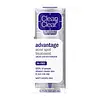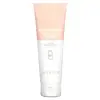What's inside
What's inside
 Key Ingredients
Key Ingredients

 Benefits
Benefits

 Concerns
Concerns

 Ingredients Side-by-side
Ingredients Side-by-side

Salicylic Acid 2%
MaskingAlcohol
AntimicrobialAmmonium Hydroxide
BufferingBenzalkonium Chloride
AntimicrobialButylene Glycol
HumectantC12-15 Alkyl Lactate
EmollientC13-14 Isoparaffin
EmollientCapryloyl Glycine
CleansingCedrus Atlantica Bark Extract
PerfumingCetyl Lactate
EmollientCinnamomum Zeylanicum Bark Extract
AntimicrobialCocamidopropyl Pg-Dimonium Chloride Phosphate
Cyclopentasiloxane
EmollientDehydroxanthan Gum
Emulsion StabilisingGlycerin
HumectantHamamelis Virginiana Water
AstringentLaureth-7
EmulsifyingMethylparaben
PreservativeParfum
MaskingPhenethyl Dimethicone
EmollientPhenoxyethanol
PreservativePolyacrylamide
Polysorbate 20
EmulsifyingPortulaca Oleracea Extract
Skin ConditioningPPG-2 Isoceteth-20 Acetate
EmulsifyingPropylene Glycol
HumectantPropylparaben
PreservativeSarcosine
Skin ConditioningSd Alcohol 40-B
AstringentT-Butyl Alcohol
PerfumingTetrasodium EDTA
Water
Skin ConditioningSalicylic Acid 2%, Alcohol, Ammonium Hydroxide, Benzalkonium Chloride, Butylene Glycol, C12-15 Alkyl Lactate, C13-14 Isoparaffin, Capryloyl Glycine, Cedrus Atlantica Bark Extract, Cetyl Lactate, Cinnamomum Zeylanicum Bark Extract, Cocamidopropyl Pg-Dimonium Chloride Phosphate, Cyclopentasiloxane, Dehydroxanthan Gum, Glycerin, Hamamelis Virginiana Water, Laureth-7, Methylparaben, Parfum, Phenethyl Dimethicone, Phenoxyethanol, Polyacrylamide, Polysorbate 20, Portulaca Oleracea Extract, PPG-2 Isoceteth-20 Acetate, Propylene Glycol, Propylparaben, Sarcosine, Sd Alcohol 40-B, T-Butyl Alcohol, Tetrasodium EDTA, Water
Water
Skin ConditioningGlycerin
HumectantPalmitic Acid
EmollientStearic Acid
CleansingLauric Acid
CleansingMyristic Acid
CleansingPotassium Hydroxide
BufferingMilk Protein Extract
Potassium Cocoyl Glycinate
Sodium Methyl Cocoyl Taurate
CleansingPEG-100 Stearate
Glyceryl Stearate
EmollientBeeswax
Emulsion StabilisingPolyquaternium-7
Ethyl Hexanediol
SolventParfum
MaskingCocamidopropyl Betaine
CleansingGlyceryl Caprylate
EmollientSodium Chloride
MaskingHydroxyethylcellulose
Emulsion StabilisingSodium Benzoate
MaskingDisodium EDTA
Linum Usitatissimum Seed Extract
PerfumingNelumbo Nucifera Flower Water
TonicOriganum Vulgare Leaf Extract
Skin ConditioningEucalyptus Globulus Leaf Extract
PerfumingHibiscus Sabdariffa Flower Extract
Skin ConditioningCamellia Sinensis Leaf Extract
AntimicrobialSalvia Hispanica Seed Extract
EmollientHedera Helix Leaf Extract
Skin ConditioningPinus Sylvestris Leaf Extract
Tonic1,2-Hexanediol
Skin ConditioningNiacinamide
SmoothingMacadamia Ternifolia Seed Oil
EmollientBacillus/Soybean Ferment Extract
Skin ConditioningBiotin
AntiseborrhoeicSalicylic Acid
MaskingCeramide NP
Skin ConditioningSodium Hyaluronate
HumectantPrunus Amygdalus Dulcis Oil
Skin ConditioningAscorbyl Tetraisopalmitate
AntioxidantHamamelis Virginiana Bark/Leaf/Twig Extract
Skin ConditioningPanthenol
Skin ConditioningTocopheryl Acetate
AntioxidantGalactomyces Ferment Filtrate
HumectantRice Ferment Filtrate
Skin ConditioningButylene Glycol
HumectantPEG-40 Hydrogenated Castor Oil
EmulsifyingLactic Acid
BufferingCentella Asiatica Extract
CleansingRetinyl Palmitate
Skin ConditioningCitric Acid
BufferingRoyal Jelly Extract
Skin ConditioningPCA
HumectantPropylene Glycol
HumectantGlycolic Acid
BufferingPhenoxyethanol
PreservativeMalic Acid
BufferingChamomilla Recutita Flower Extract
MaskingPyruvic Acid
MaskingTocopherol
AntioxidantTartaric Acid
BufferingHydroxypropyl Cyclodextrin
MaskingGlutathione
Hydroxycitronellal
PerfumingWater, Glycerin, Palmitic Acid, Stearic Acid, Lauric Acid, Myristic Acid, Potassium Hydroxide, Milk Protein Extract, Potassium Cocoyl Glycinate, Sodium Methyl Cocoyl Taurate, PEG-100 Stearate, Glyceryl Stearate, Beeswax, Polyquaternium-7, Ethyl Hexanediol, Parfum, Cocamidopropyl Betaine, Glyceryl Caprylate, Sodium Chloride, Hydroxyethylcellulose, Sodium Benzoate, Disodium EDTA, Linum Usitatissimum Seed Extract, Nelumbo Nucifera Flower Water, Origanum Vulgare Leaf Extract, Eucalyptus Globulus Leaf Extract, Hibiscus Sabdariffa Flower Extract, Camellia Sinensis Leaf Extract, Salvia Hispanica Seed Extract, Hedera Helix Leaf Extract, Pinus Sylvestris Leaf Extract, 1,2-Hexanediol, Niacinamide, Macadamia Ternifolia Seed Oil, Bacillus/Soybean Ferment Extract, Biotin, Salicylic Acid, Ceramide NP, Sodium Hyaluronate, Prunus Amygdalus Dulcis Oil, Ascorbyl Tetraisopalmitate, Hamamelis Virginiana Bark/Leaf/Twig Extract, Panthenol, Tocopheryl Acetate, Galactomyces Ferment Filtrate, Rice Ferment Filtrate, Butylene Glycol, PEG-40 Hydrogenated Castor Oil, Lactic Acid, Centella Asiatica Extract, Retinyl Palmitate, Citric Acid, Royal Jelly Extract, PCA, Propylene Glycol, Glycolic Acid, Phenoxyethanol, Malic Acid, Chamomilla Recutita Flower Extract, Pyruvic Acid, Tocopherol, Tartaric Acid, Hydroxypropyl Cyclodextrin, Glutathione, Hydroxycitronellal
Ingredients Explained
These ingredients are found in both products.
Ingredients higher up in an ingredient list are typically present in a larger amount.
Butylene Glycol (or BG) is used within cosmetic products for a few different reasons:
Overall, Butylene Glycol is a safe and well-rounded ingredient that works well with other ingredients.
Though this ingredient works well with most skin types, some people with sensitive skin may experience a reaction such as allergic rashes, closed comedones, or itchiness.
Learn more about Butylene GlycolGlycerin is already naturally found in your skin. It helps moisturize and protect your skin.
A study from 2016 found glycerin to be more effective as a humectant than AHAs and hyaluronic acid.
As a humectant, it helps the skin stay hydrated by pulling moisture to your skin. The low molecular weight of glycerin allows it to pull moisture into the deeper layers of your skin.
Hydrated skin improves your skin barrier; Your skin barrier helps protect against irritants and bacteria.
Glycerin has also been found to have antimicrobial and antiviral properties. Due to these properties, glycerin is often used in wound and burn treatments.
In cosmetics, glycerin is usually derived from plants such as soybean or palm. However, it can also be sourced from animals, such as tallow or animal fat.
This ingredient is organic, colorless, odorless, and non-toxic.
Glycerin is the name for this ingredient in American English. British English uses Glycerol/Glycerine.
Learn more about GlycerinParfum is a catch-all term for an ingredient or more that is used to give a scent to products.
Also called "fragrance", this ingredient can be a blend of hundreds of chemicals or plant oils. This means every product with "fragrance" or "parfum" in the ingredients list is a different mixture.
For instance, Habanolide is a proprietary trade name for a specific aroma chemical. When used as a fragrance ingredient in cosmetics, most aroma chemicals fall under the broad labeling category of “FRAGRANCE” or “PARFUM” according to EU and US regulations.
The term 'parfum' or 'fragrance' is not regulated in many countries. In many cases, it is up to the brand to define this term.
For instance, many brands choose to label themselves as "fragrance-free" because they are not using synthetic fragrances. However, their products may still contain ingredients such as essential oils that are considered a fragrance by INCI standards.
One example is Calendula flower extract. Calendula is an essential oil that still imparts a scent or 'fragrance'.
Depending on the blend, the ingredients in the mixture can cause allergies and sensitivities on the skin. Some ingredients that are known EU allergens include linalool and citronellol.
Parfum can also be used to mask or cover an unpleasant scent.
The bottom line is: not all fragrances/parfum/ingredients are created equally. If you are worried about fragrances, we recommend taking a closer look at an ingredient. And of course, we always recommend speaking with a professional.
Learn more about ParfumPhenoxyethanol is a preservative that has germicide, antimicrobial, and aromatic properties. Studies show that phenoxyethanol can prevent microbial growth. By itself, it has a scent that is similar to that of a rose.
It's often used in formulations along with Caprylyl Glycol to preserve the shelf life of products.
Propylene Glycol is an odorless, colorless liquid. As a humectant, it helps skin retain moisture. It also aids in delivering active ingredients.
Another role of this ingredient is preventing a product from melting or freezing. Propylene glycol also adds antimicrobrial properties to a product, elongating product lifespan.
This ingredient is considered an organic alcohol and commonly added into both cosmetics and foods.
Those with sensitive skin or conditions may develop a rash when using this ingredient.
Learn more about Propylene GlycolSalicylic Acid (also known as beta hydroxy acid or BHA) is a well-known ingredient for treating skin that struggles with acne and clogged pores. It exfoliates both the skin's surface and deep within the pores to help clear out buildup, control oil, and reduce inflammation.
Unlike AHAs (alpha hydroxy acids), salicylic acid is oil-soluble. This allows it to penetrate into pores which makes it especially effective for treating blackheads and preventing future breakouts.
Salicylic acid is also known for its soothing properties. It has a similar structure to aspirin and can calm inflamed or irritated skin, making it a good option for acne-prone skin that is also sensitive.
Concentrations of 0.5-2% are recognized by the U.S. FDA as an over-the-counter topical acne product.
It can cause irritation and/or dryness if one's skin already has a compromised moisture barrier, so it's best to focus on repairing that before introducing this ingredient into your routine.
While salicylic acid does not increase sun sensitivity, it’s still important to wear sunscreen daily to protect your skin.
If you are looking for the ingredient called BHA or Butylated Hydroxyanisole, click here.
Learn more about Salicylic AcidWater. It's the most common cosmetic ingredient of all. You'll usually see it at the top of ingredient lists, meaning that it makes up the largest part of the product.
So why is it so popular? Water most often acts as a solvent - this means that it helps dissolve other ingredients into the formulation.
You'll also recognize water as that liquid we all need to stay alive. If you see this, drink a glass of water. Stay hydrated!
Learn more about Water